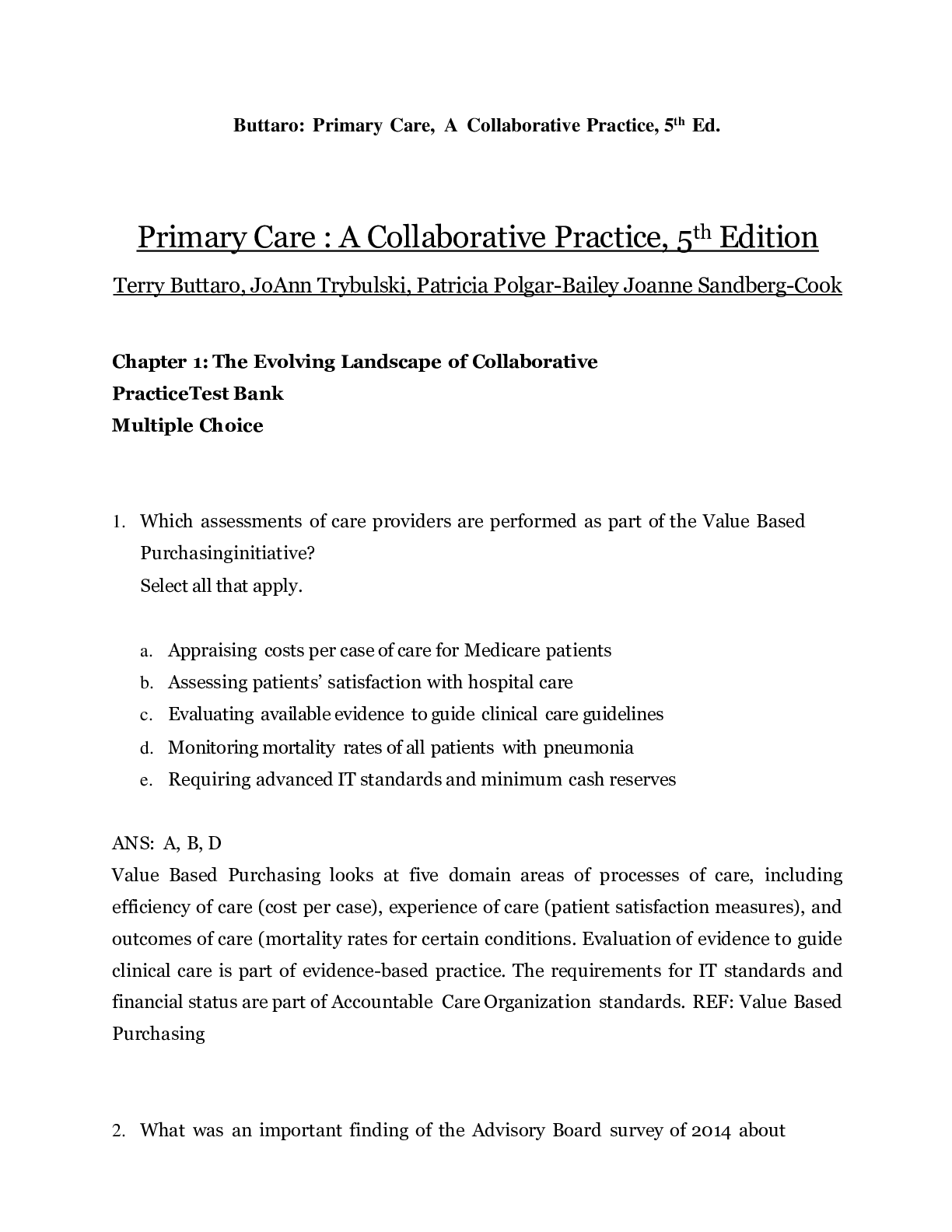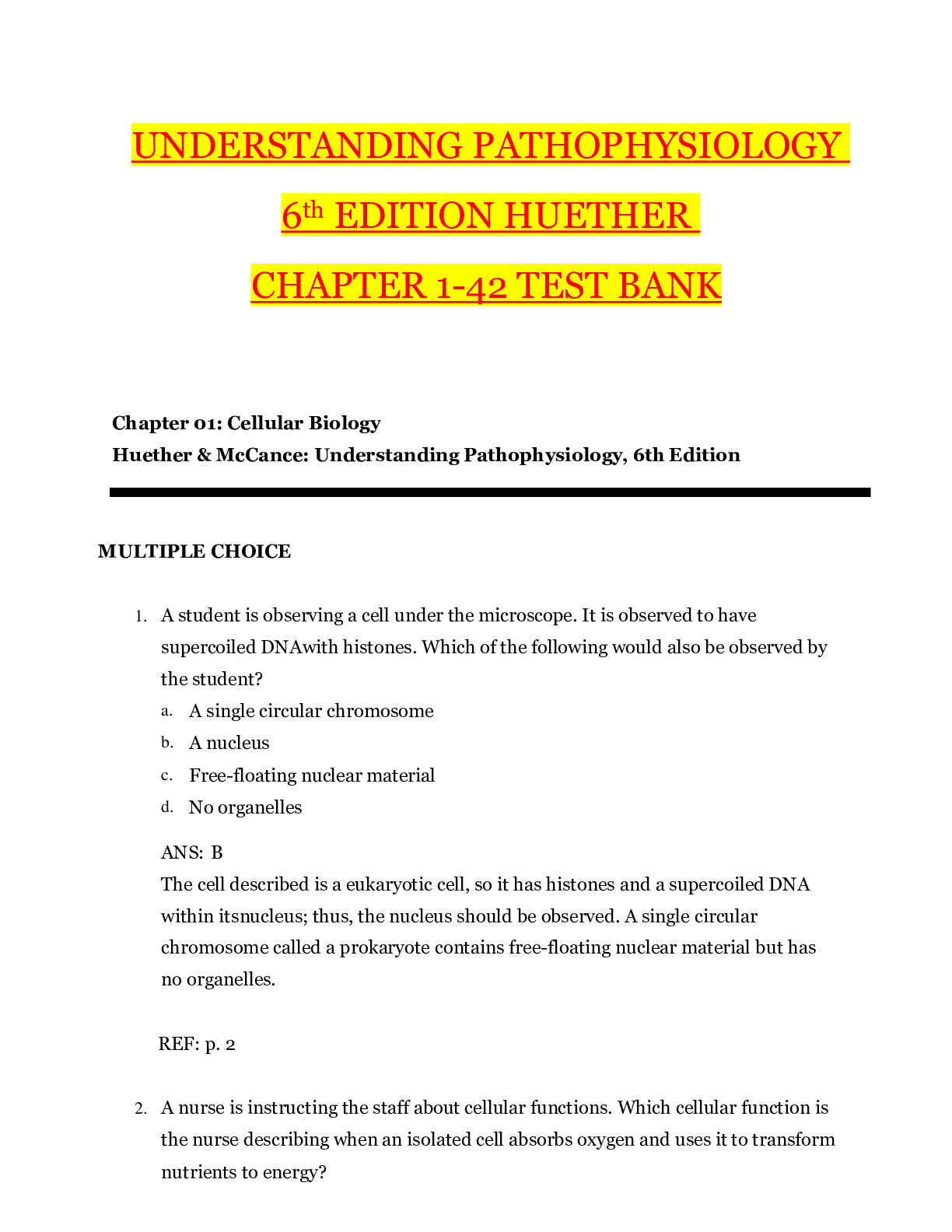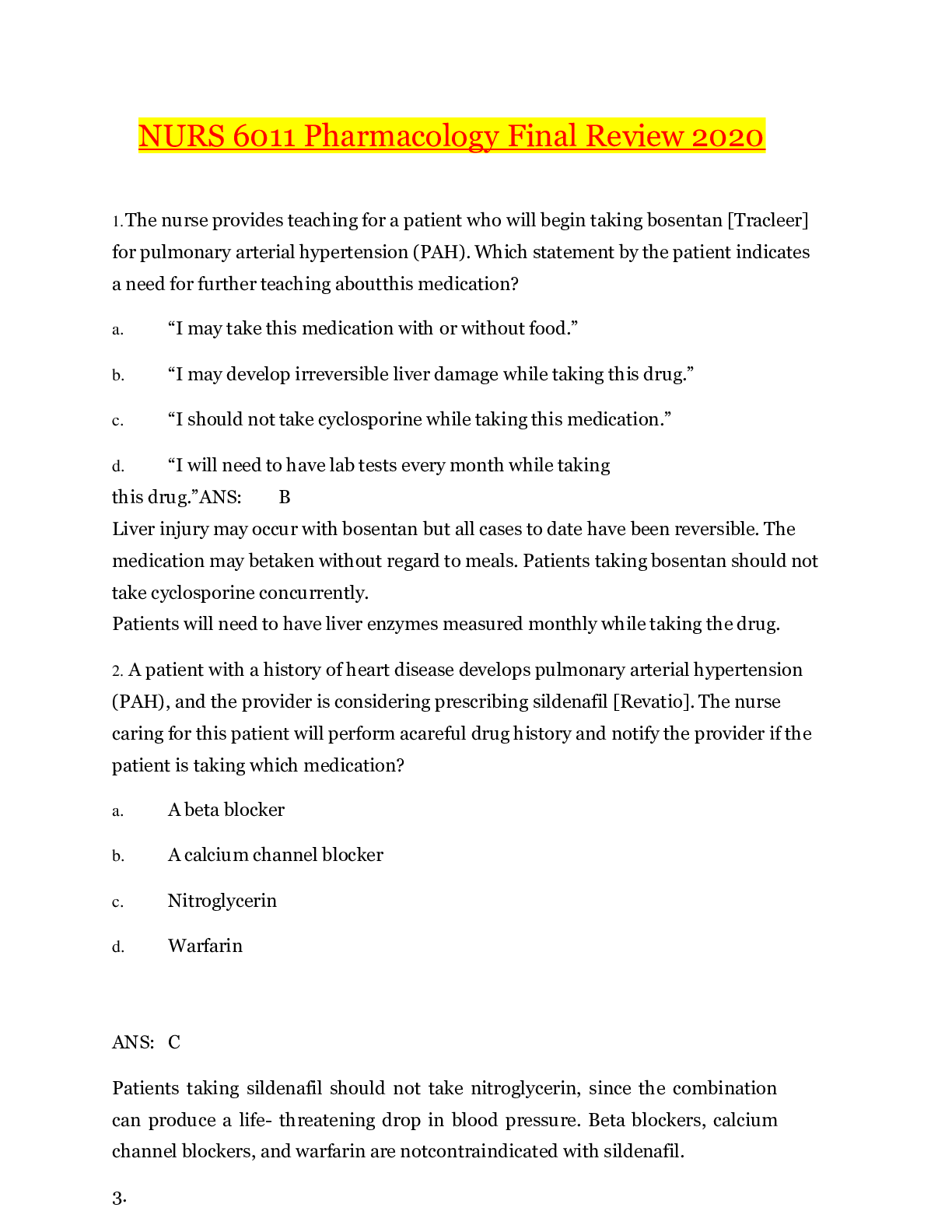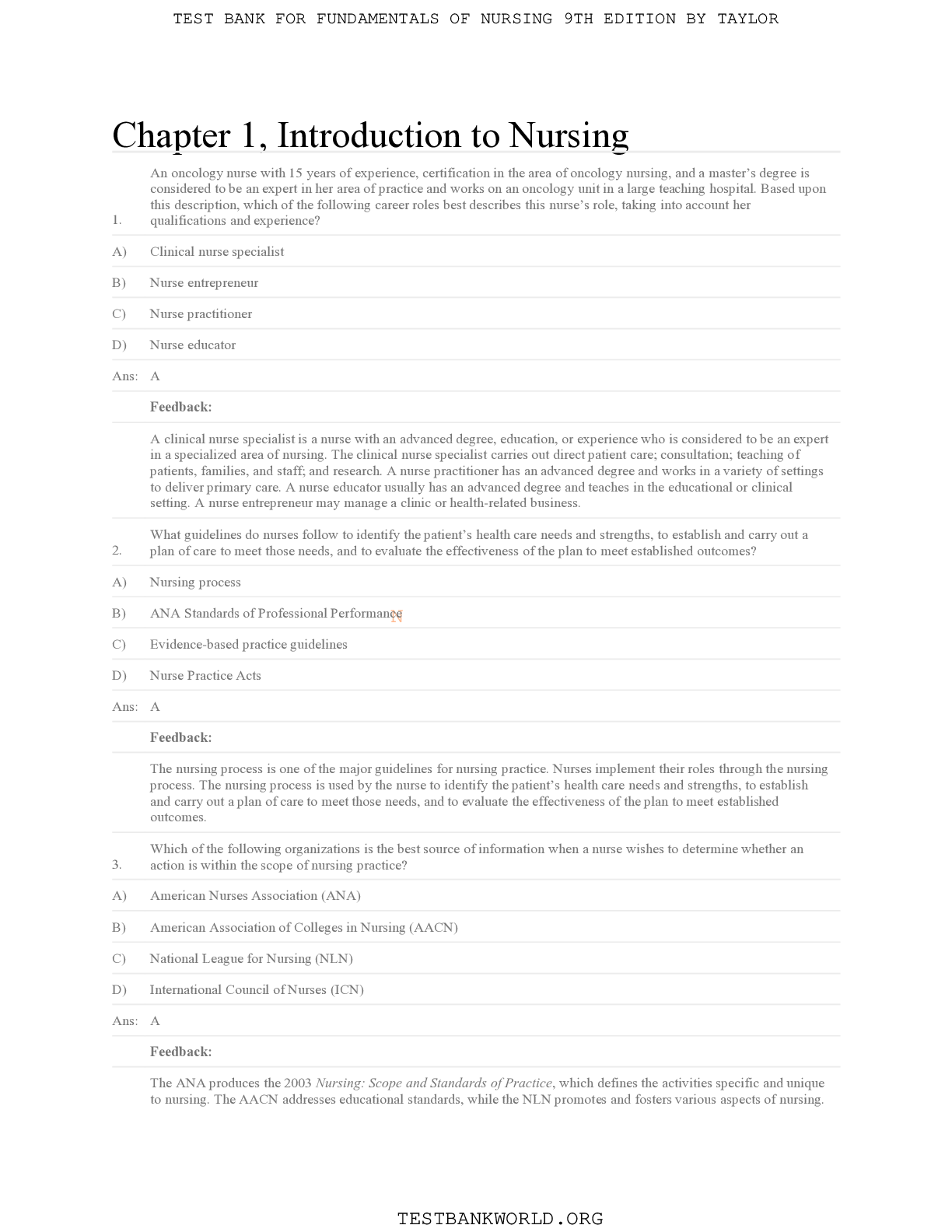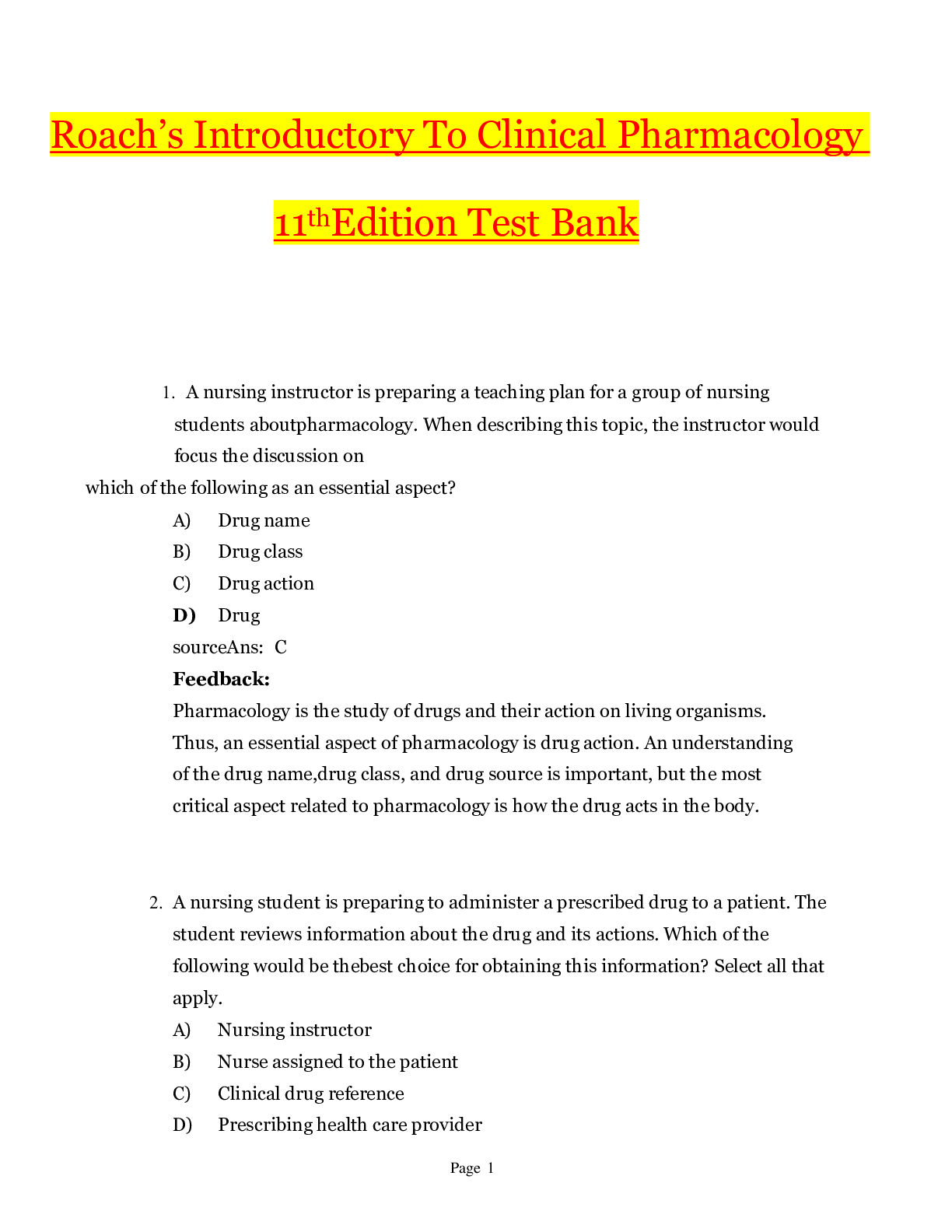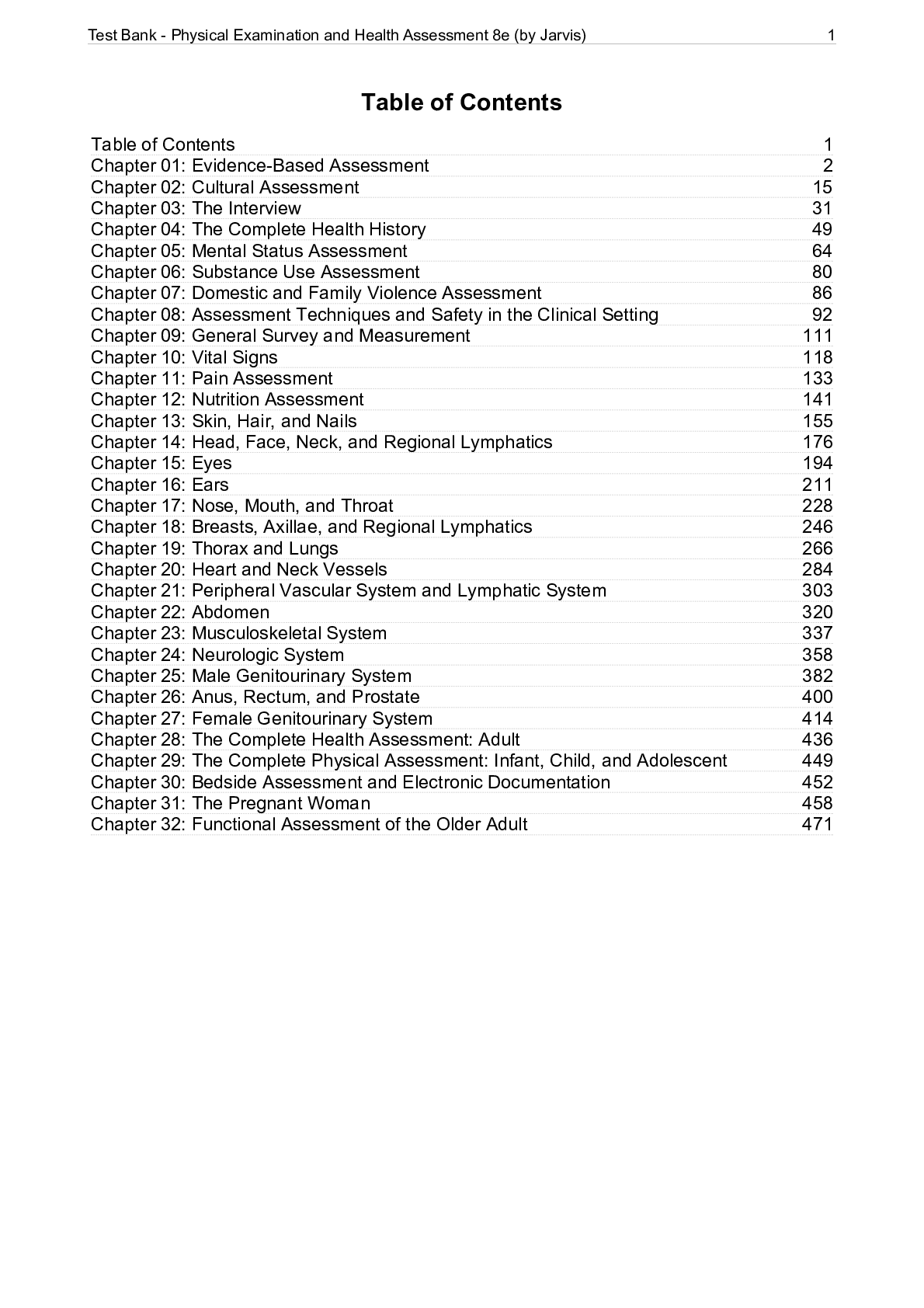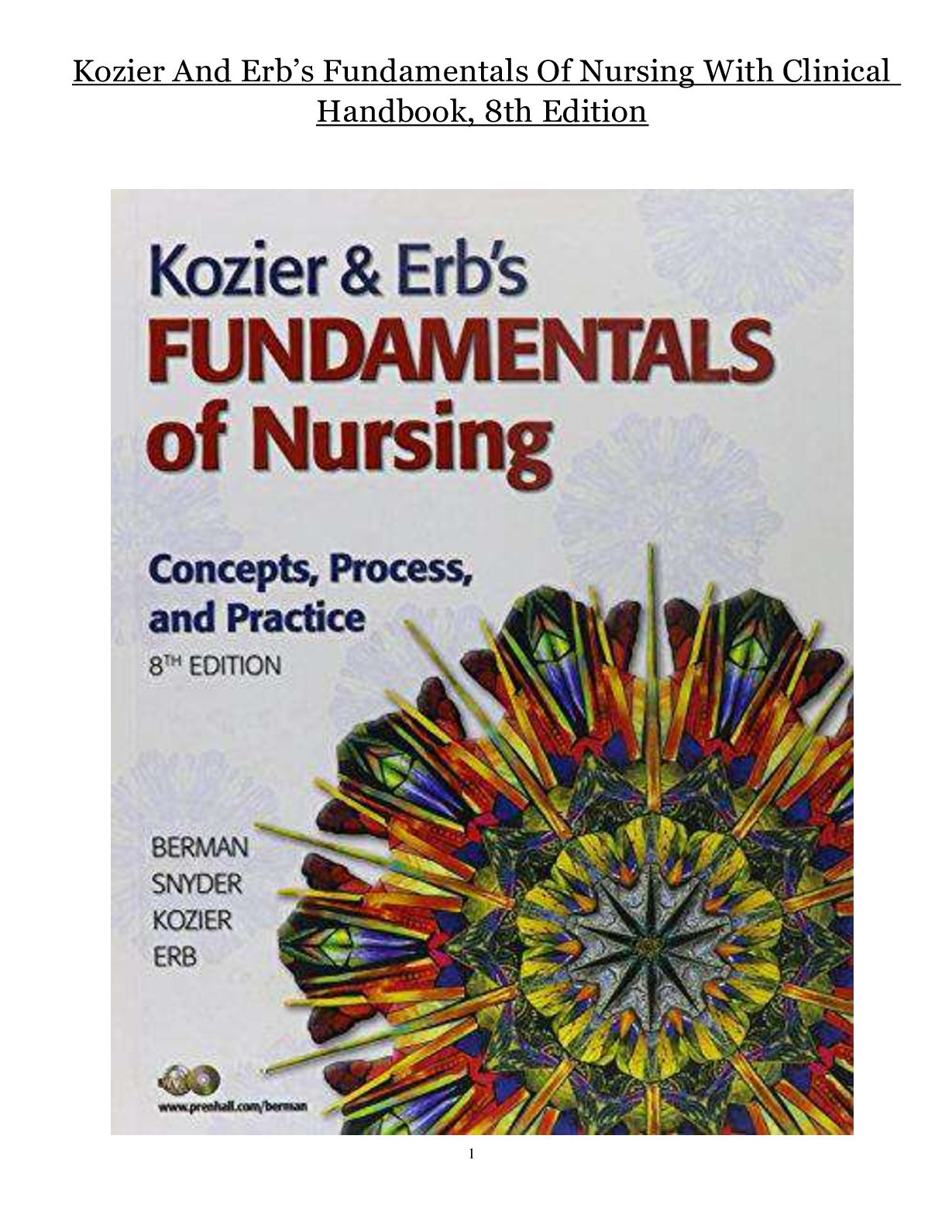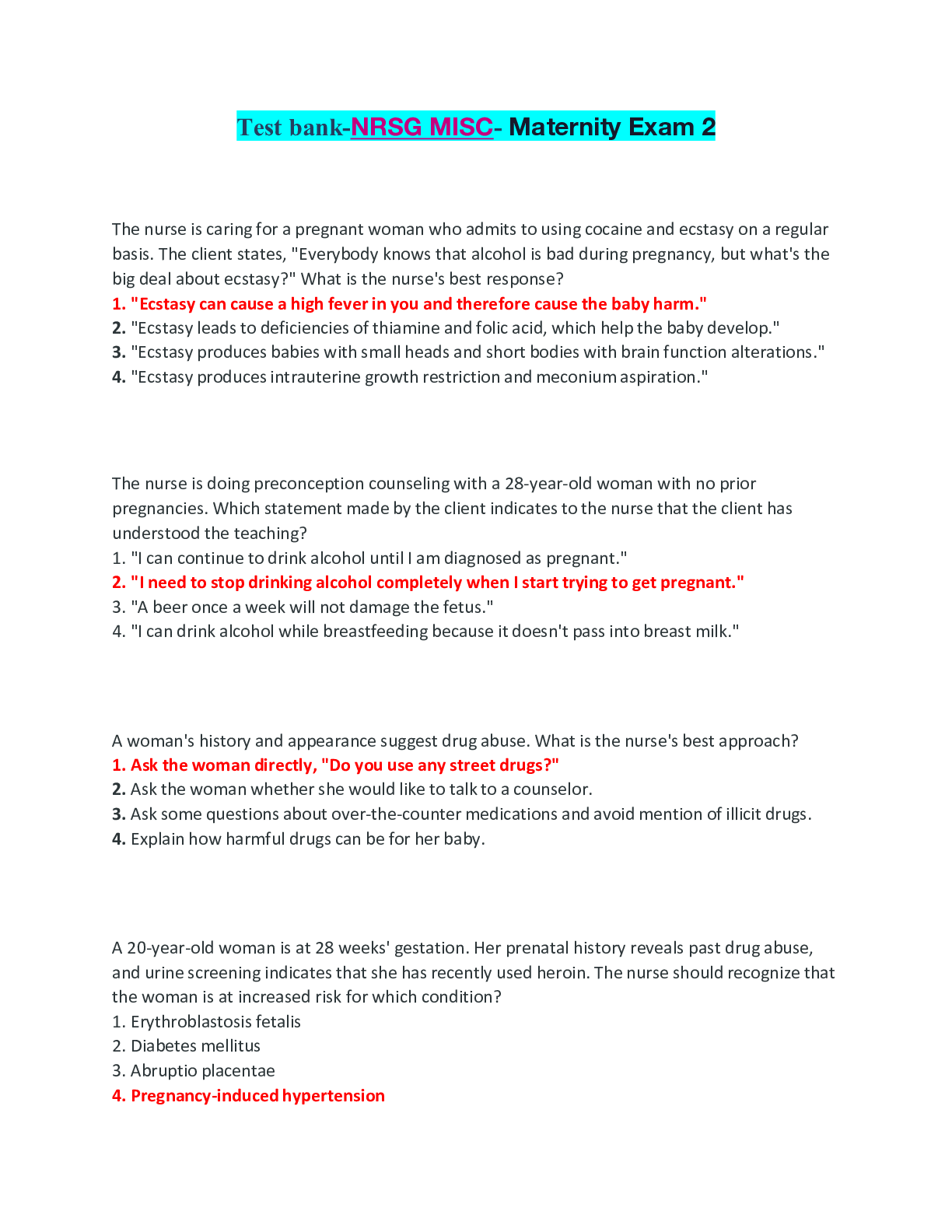*NURSING > TEST BANK > Maternity Exam TEST BANK Spring 2020_A Grade | Maternity Exam 2 TEST BANK Spring 2020 | All Correct (All)
Maternity Exam TEST BANK Spring 2020_A Grade | Maternity Exam 2 TEST BANK Spring 2020 | All Correct answers
Document Content and Description Below
Maternity Exam 2 TEST BANK Spring 2020 180+ pages of multiple-choice questions. All Correct answers The nurse is caring for a pregnant woman who admits to using cocaine and ecstasy on a regular... basis. The client states, "Everybody knows that alcohol is bad during pregnancy, but what's the big deal about ecstasy?" What is the nurse's best response? 1. "Ecstasy can cause a high fever in you and therefore cause the baby harm." 2. "Ecstasy leads to deficiencies of thiamine and folic acid, which help the baby develop." 3. "Ecstasy produces babies with small heads and short bodies with brain function alterations." 4. "Ecstasy produces intrauterine growth restriction and meconium aspiration." The nurse is doing preconception counseling with a 28-year-old woman with no prior pregnancies. Which statement made by the client indicates to the nurse that the client has understood the teaching? 1. "I can continue to drink alcohol until I am diagnosed as pregnant." 2. "I need to stop drinking alcohol completely when I start trying to get pregnant." 3. "A beer once a week will not damage the fetus." 4. "I can drink alcohol while breastfeeding because it doesn't pass into breast milk." A woman's history and appearance suggest drug abuse. What is the nurse's best approach? 1. Ask the woman directly, "Do you use any street drugs?" 2. Ask the woman whether she would like to talk to a counselor. 3. Ask some questions about over-the-counter medications and avoid mention of illicit drugs. 4. Explain how harmful drugs can be for her baby. A 20-year-old woman is at 28 weeks' gestation. Her prenatal history reveals past drug abuse, and urine screening indicates that she has recently used heroin. The nurse should recognize that the woman is at increased risk for which condition? 1. Erythroblastosis fetalis 2. Diabetes mellitus 3. Abruptio placentae 4. Pregnancy-induced hypertension The nurse is working with a woman who abuses stimulants. The nurse is aware that the fetus is at risk for which of the following? Select all that apply. 1. Withdrawal symptoms 2. Cardiac anomalies 3. Sudden infant death syndrome 4. Being small for gestational age 5. Fetal alcohol syndrome The nurse is assessing a woman at 10 weeks' gestation who is addicted to alcohol. The woman asks the nurse, "What is the point of stopping drinking now if my baby probably has been hurt by it already?" What is the best response by the nurse? 1. "It won't help your baby, but you will feel better during your pregnancy if you stop now." 2. "If you stop now, you and your baby have less chance of serious complications." 3. "If you limit your drinking to once a week, your baby will be okay." 4. "You might as well stop it now, because once your baby is born, you'll have to give up alcohol if you plan on breastfeeding." The client has just been diagnosed as diabetic. The nurse knows teaching was effective when the client makes which statement? 1. "Ketones in my urine mean that my body is using the glucose appropriately." 2. "I should be urinating frequently and in large amounts to get rid of the extra sugar." 3. "My pancreas is making enough insulin, but my body isn't using it correctly." 4. "I might be hungry frequently because the sugar isn't getting into the tissues the way it should." The client with insulin-dependent type 2 diabetes and an HbA1c of 5.0% is planning to become pregnant soon. What anticipatory guidance should the nurse provide this client? 1. Insulin needs decrease in the first trimester and usually begin to rise late in the first trimester as glucose use and glycogen storage by the woman and fetus increase. 2. The risk of ketoacidosis decreases during the length of the pregnancy. 3. Vascular disease that accompanies diabetes slows progression. 4. The baby is likely to have a congenital abnormality because of the diabetes. A newly diagnosed insulin-dependent type 1 diabetic with good blood sugar control is at 20 weeks' gestation. She asks the nurse how her diabetes will affect her baby. What would the best explanation include? 1. "Your baby could be smaller than average at birth." 2. "Your baby will probably be larger than average at birth." 3. "As long as you control your blood sugar, your baby will not be affected at all." 4. "Your baby might have high blood sugar for several days." A 26-year-old client is 28 weeks pregnant. She has developed gestational diabetes. She is following a program of regular exercise, which includes walking, bicycling, and swimming. What instructions should be included in a teaching plan for this client? 1. "Exercise either just before meals or wait until 2 hours after a meal." 2. "Carry hard candy (or other simple sugar) when exercising." 3. "If your blood sugar is 120 mg/dL, eat 20 g of carbohydrate." 4. "If your blood sugar is more than 120 mg/dL, drink a glass of whole milk." A 26-year-old client is 26 weeks pregnant. Her previous births include two large-for-gestational-age babies and one unexplained stillbirth. Which tests would the nurse anticipate as being most definitive in diagnosing gestational diabetes? 1. A 50g, 1-hour glucose screening test 2. A single fasting glucose level 3. A 100g, 1-hour glucose tolerance test 4. A 100g, 3-hour glucose tolerance test A client with diabetes is receiving preconception counseling. The nurse will emphasize that during the first trimester, the woman should be prepared for which of the following? 1. The need for less insulin than she normally uses 2. Blood testing for anemia 3. Assessment for respiratory complications 4. Assessment for contagious conditions The nurse has written the nursing diagnosis Injury, Risk for a diabetic pregnant client. Interventions for this diagnosis include which of the following? Select all that apply. 1. Assessment of fetal heart tones 2. Perform oxytocin challenge test, if ordered 3. Refer the client to a diabetes support group 4. Assist with the biophysical profile assessment 5. Develop an appropriate teaching plan A diabetic client goes into labor at 36 weeks' gestation. Provided that tests for fetal lung maturity are successful, the nurse will anticipate which of the following interventions? Select all that apply. 1. Administration of tocolytic therapy 2. Beta-sympathomimetic administration 3. Allowance of labor to progress 4. Hourly blood glucose monitoring 5. Cesarean birth may be indicated if evidence of reassuring fetal status exists A woman asks her nurse what she can do before she begins trying to get pregnant to help her baby, as she is prone to anemia. What would the nurse correctly advise her to do? 1. Get pregnant, then start iron supplementation. 2. Add more carbohydrates to her diet. 3. Begin taking folic acid supplements daily. 4. Have a hemoglobin baseline done now so her progress can be followed. The client with thalassemia intermedia has a hemoglobin level of 9.0. The nurse is preparing an education session for the client. Which statement should the nurse include? 1. "You need to increase your intake of meat and other iron-rich foods." 2. "Your low hemoglobin could put you into preterm labor." 3. "Increasing your vitamin C intake will help your hemoglobin level." 4. "You should not take iron supplements." The client at 20 weeks' gestation has had an ultrasound that revealed a neural tube defect in her fetus. The client's hemoglobin level is 8.5. The nurse should include which statement when discussing these findings with the client? 1. "Your low iron intake has caused anemia, which leads to the neural tube defect." 2. "You should increase your vitamin C intake to improve your anemia." 3. "You are too picky about food. Your poor diet caused your baby's defect." 4. "You haven't had enough folic acid in your diet. You should take a supplement." The clinic nurse is teaching a pregnant client about her iron supplement. Which information is included in the teaching? Note: Credit will be given only if all correct and no incorrect choices are selected. Select all that apply. 1. Iron does not affect the gastrointestinal tract. 2. A stool softener might be needed. 3. Start a low dose, and increase it gradually. 4. Expect the stools to be black and bloody. 5. Iron absorption is poor if taken with meals. The client at 9 weeks' gestation has been told that her HIV test was positive. The client is very upset, and tells the nurse, "I didn't know I had HIV! What will this do to my baby?" The nurse knows teaching has been effective when the client makes which statement? 1. "I cannot take the medications that control HIV during my pregnancy, because they will harm the baby." 2. "My baby can get HIV during the pregnancy and through my breast milk." 3. "The pregnancy will increase the progression of my disease and will reduce my CD4 counts." 4. "The HIV won't affect my baby, and I will have a low-risk pregnancy without additional testing." During the history, the client admits to being HIV-positive and says she knows that she is about 16 weeks pregnant. Which statements made by the client indicate an understanding of the plan of care both during the pregnancy and postpartally? Select all that apply. 1. "During labor and delivery, I can expect the zidovudine (ZDV) to be given in my IV." 2. "After delivery, the dose of zidovudine (ZDV) will be doubled to prevent further infection." 3. "My baby will be started on zidovudine (ZDV) for six weeks following the birth." 4. "My baby's zidovudine (ZDV) will be given in a cream form." 5. "My baby will not need zidovudine (ZDV) if I take it during my pregnancy." A woman is 32 weeks pregnant. She is HIV-positive but asymptomatic. The nurse knows what would be important in managing her pregnancy and delivery? 1. An amniocentesis at 30 and 36 weeks 2. Weekly non-stress testing beginning at 32 weeks' gestation 3. Application of a fetal scalp electrode as soon as her membranes rupture in labor 4. Administration of intravenous antibiotics during labor and delivery A pregnant woman is married to an intravenous drug user. She had a negative HIV screening test just after missing her first menstrual period. What would indicate that the client needs to be retested for HIV? 1. Hemoglobin of 11 g/dL and a rapid weight gain 2. Elevated blood pressure and ankle edema 3. Shortness of breath and frequent urination 4. Persistent candidiasis The nurse is evaluating the goal "Client will remain free of opportunistic infections" for an HIV-positive pregnant client. The nurse determines the goal was met when the client has which of the following? Select all that apply. 1. An absolute CD4+ T-lymphocyte count below 200 2. No complaint of chills or fever during the pregnancy 3. Weight gain of 30 lbs during the pregnancy 4. ESR above 20 mm/hr 5. Normal erythrocyte sedimentation rate maintained during the pregnancy Women with HIV should be evaluated and treated for other sexually transmitted infections and for what condition occurring more commonly in women with HIV? 1. Syphilis 2. Toxoplasmosis 3. Gonorrhea 4. Herpes A 21-year-old at 12 weeks' gestation with her first baby has known cardiac disease, class III, as a result of childhood rheumatic fever. During a prenatal visit, the nurse reviews the signs of cardiac decompensation with her. The nurse will know that the client understands these signs and symptoms if she states that she would notify her doctor if she had which symptom? 1. "A pulse rate increase of 10 beats per minute" 2. "Breast tenderness" 3. "Mild ankle edema" 4. "A frequent cough" A client is at 12 weeks' gestation with her first baby. She has cardiac disease, class III. She states that she had been taking sodium warfarin (Coumadin), but her physician changed her to heparin. She asks the nurse why this was done. What should the nurse's response be? 1. "Heparin is used when coagulation problems are resolved." 2. "Heparin is safer because it does not cross the placenta." 3. "They are the same drug, but heparin is less expensive." 4. "Coumadin interferes with iron absorption in the intestines." A 21-year-old woman is at 12 weeks' gestation with her first baby. She has cardiac disease, class III, as a result of having had childhood rheumatic fever. Which planned activity would indicate to the nurse that the client needs further teaching? 1. "I will be sure to take a rest period every afternoon." 2. "I would like to take childbirth education classes in my last trimester." 3. "I will have to cancel our trip to Disney World." 4. "I am going to start my classes in water aerobics next week." Which of the following symptoms, if progressive, are indicative of CHF, the heart's signal of its decreased ability to meet the demands of pregnancy? Select all that apply. - - - - - - - - - - - - - - - - - - - - - - - - - - - - - - - - - - - - - -- - - - - - - - Benefits of skin-to-skin care as a developmental intervention include which of the following? Select all that apply. 1. Routine discharge 2. Stabilization of vital signs 3. Increased periods of awake-alert state 4. Decline in the episodes of apnea and bradycardia 5. Increased growth parameters In caring for the premature newborn, the nurse must assess hydration status continually. Assessment parameters should include which of the following? Select all that apply. 1. Volume of urine output 2. Weight 3. Blood pH 4. Head circumference 5. Bowel sounds The nurse is planning care for a preterm newborn. Which nursing diagnosis has the highest priority? 1. Tissue Integrity, Impaired 2. Infection, Risk for 3. Gas Exchange, Impaired 4. Family Processes, Dysfunctional The nurse is teaching the parents of an infant with an inborn error of metabolism how to care for the infant at home. What information does teaching include? 1. Specially prepared formulas 2. Cataract problems 3. Low glucose concentrations 4. Administration of thyroid medication The nurse is caring for a newborn in the special care nursery. The infant has hydrocephalus, and is positioned in a prone position. The nurse is especially careful to cleanse all stool after bowel movements. This care is most appropriate for an infant born with which of the following? 1. Omphalocele 2. Gastroschisis 3. Diaphragmatic hernia 4. Myelomeningocele The nurse is caring for a newborn with full fontanelles and "setting sun" eyes. Which nursing interventions should be included in the care plan? Select all that apply. 1. Measure head circumference daily. 2. Assess for bulging fontanelles. 3. Avoid position changes. 4. Watch for signs of infection. 5. Use a gel pillow under the head. During discharge planning for a drug-dependent newborn, the nurse explains to the mother how to do which of the following? 1. Place the newborn in a prone position. 2. Limit feedings to three a day to decrease diarrhea. 3. Place the infant supine and operate a home apnea-monitoring system. 4. Wean the newborn off the pacifier. The nurse is assessing a drug-dependent newborn. Which symptom would require further assessment by the nurse? 1. Occasional watery stools 2. Spitting up after feeding 3. Jitteriness and irritability 4. Nasal stuffiness Parents have been told their child has fetal alcohol syndrome (FAS). Which statement by a parent indicates that additional teaching is required? 1. "Our baby's heart murmur is from this syndrome." 2. "He might be a fussy baby because of this." 3. "His face looks like it does due to this problem." 4. "Cuddling and rocking will help him stay calm." The nurse is caring for the newborn of a drug-addicted mother. Which assessment findings would be typical for this newborn? Select all that apply. 1. Hyperirritability 2. Decreased muscle tone 3. Exaggerated reflexes 4. Low pitched cry 5. Transient tachypnea In planning care for the fetal alcohol syndrome (FAS) newborn, which intervention would the nurse include? 1. Allow extra time with feedings. 2. Assign different personnel to the newborn each day. 3. Place the newborn in a well-lit room. 4. Monitor for hyperthermia. The nurse is teaching the parents of a newborn who has been exposed to HIV how to care for the newborn at home. Which instructions should the nurse emphasize? Select all that apply. 1. Use proper hand-washing technique. 2. Provide three feedings per day. 3. Place soiled diapers in a sealed plastic bag. 4. Cleanse the diaper changing area with a 1:10 bleach solution after each diaper change. 5. Take the temperature rectally. A mother who is HIV-positive has given birth to a term female. What plan of care is most appropriate for this infant? 1. Test with a HIV serologic test at 8 months. 2. Begin prophylactic AZT (Zidovudine) administration. 3. Provide 4 to 5 large feedings throughout the day. 4. Encourage the mother to breastfeed the child. An HIV-positive mother delivered 2 days ago. The infant will be placed in foster care. The nurse is planning discharge teaching for the foster parents on how to care for the newborn at home. Which instructions should the nurse include? 1. Do not add food supplements to the baby's diet. 2. Place soiled diapers in a sealed plastic bag. 3. Wash soiled linens in cool water with bleach. 4. Shield the baby's eyes from bright lights. Many newborns exposed to HIV/AIDS show signs and symptoms of disease within days of birth that include which of the following? Select all that apply. 1. Swollen glands 2. Hard stools 3. Smaller than average spleen and liver 4. Rhinorrhea 5. Interstitial pneumonia The nurse is analyzing assessment findings on four newborns. Which finding might suggest a congenital heart defect? 1. Apical heart rate of 140 beats per minute 2. Respiratory rate of 40 3. Temperature of 36.5°C 4. Visible, blue discoloration of the skin The parents of a newborn have just been told their infant has tetralogy of Fallot. The parents do not seem to understand the explanation given by the physician. What statement by the nurse is best? 1. "With this defect, not enough of the blood circulates through the lungs, leading to a lack of oxygen in the baby's body." 2. "The baby's aorta has a narrowing in a section near the heart that makes the left side of the heart work harder." 3. "The blood vessels that attach to the ventricles of the heart are positioned on the wrong sides of the heart." 4. "Your baby's heart doesn't circulate blood well because the left ventricle is smaller and thinner than normal." Which assessment findings would lead the nurse to suspect that a newborn might have a congenital heart defect? Select all that apply. 1. Cyanosis 2. Heart murmur 3. Bradycardia 4. Low urinary outputs 5. Tachypnea The nurse is preparing an educational session on phenylketonuria for a family whose neonate has been diagnosed with the condition. Which statement by a parent indicates that teaching was effective? 1. "This condition occurs more frequently among Japanese people." 2. "We must be very careful to avoid most proteins to prevent brain damage." 3. "Carbohydrates can cause our baby to develop cataracts and liver damage." 4. "Our baby's thyroid gland isn't functioning properly." The nurse prepares to admit to the nursery a newborn whose mother had meconium-stained amniotic fluid. The nurse knows this newborn might require which of the following? 1. Initial resuscitation 2. Vigorous stimulation at birth 3. Phototherapy immediately 4. An initial feeding of iron-enriched formula A laboring mother has recurrent late decelerations. At birth, the infant has a heart rate of 100, is not breathing, and is limp and bluish in color. What nursing action is best? 1. Begin chest compressions. 2. Begin direct tracheal suctioning. 3. Begin bag-and-mask ventilation. 4. Obtain a blood pressure reading. Which fetal/neonatal risk factors would lead the nurse to anticipate a potential need to resuscitate a newborn? Select all that apply. 1. Nonreassuring fetal heart rate pattern/sustained bradycardia 2. Fetal scalp/capillary blood sample pH greater than 7.25 3. History of meconium in amniotic fluid 4. Prematurity 5. Significant intrapartum bleeding During newborn resuscitation, how does the nurse evaluate the effectiveness of bag-and-mask ventilations? 1. The rise and fall of the chest 2. Sudden wakefulness 3. Urinary output 4. Adequate thermoregulation A nurse explains to new parents that their newborn has developed respiratory distress syndrome (RDS). Which of the following signs and symptoms would not be characteristic of RDS? 1. Grunting respirations 2. Nasal flaring 3. Respiratory rate of 40 during sleep 4. Chest retractions A client in labor is found to have meconium-stained amniotic fluid upon rupture of membranes. At delivery, the nurse finds the infant to have depressed respirations and a heart rate of 80. What does the nurse anticipate? 1. Delivery of the neonate on its side with head up, to facilitate drainage of secretions. 2. Direct tracheal suctioning by specially trained personnel. 3. Preparation for the immediate use of positive pressure to expand the lungs. 4. Suctioning of the oropharynx when the newborn's head is delivered. The nurse is assessing a 2-hour-old newborn delivered by cesarean at 38 weeks. The amniotic fluid was clear. The mother had preeclampsia. The newborn has a respiratory rate of 80, is grunting, and has nasal flaring. What is the most likely cause of this infant's condition? 1. Meconium aspiration syndrome 2. Transient tachypnea of the newborn 3. Respiratory distress syndrome 4. Prematurity of the neonate A nurse is caring for a newborn on a ventilator who has respiratory distress syndrome (RDS). The nurse informs the parents that the newborn is improving. Which data support the nurse's assessment? 1. Decreased urine output 2. Pulmonary vascular resistance increases 3. Increased PCO2 4. Increased urination When planning care for the premature newborn diagnosed with respiratory distress syndrome, which potential complications would the nurse anticipate? Select all that apply. 1. Hypoxia 2. Respiratory alkalosis 3. Metabolic acidosis 4. Massive atelectasis 5. Pulmonary edema Which assessment findings by the nurse would require obtaining a blood glucose level on the newborn? 1. Jitteriness 2. Sucking on fingers 3. Lusty cry 4. Axillary temperature of 98°F A nursing instructor is demonstrating how to perform a heel stick on a newborn. To obtain an accurate capillary hematocrit reading, what does the nursing instructor tell the student do? 1. Rub the heel vigorously with an isopropyl alcohol swab prior to obtaining blood. 2. Use a previous puncture site. 3. Cool the heel prior to obtaining blood. 4. Use a sterile needle and aspirate. The nurse is caring for an infant who was delivered in a car on the way to the hospital and who has developed cold stress. Which finding requires immediate intervention? 1. Increased skin temperature and respirations 2. Blood glucose level of 45 3. Room-temperature IV running 4. Positioned under radiant warmer Which nursing intervention is appropriate in the management of the preterm infant with hypothermia? Select all that apply. 1. Warm the baby rapidly to reverse the hypothermia. 2. Monitor skin temperature every 2 hours to determine whether the infant's temperature is increasing. 3. Keep IV fluids at room temperature. 4. Initiate efforts to maintain the newborn in a neutral thermal environment. 5. Warm the baby slowly to reverse hypothermia and reach a neutral thermal environment The nurse is caring for a newborn with jaundice. The parents question why the newborn is not under phototherapy lights. The nurse explains that the fiber-optic blanket is beneficial because of which of the following? Select all that apply. 1. Lights can stay on all the time. 2. The eyes do not need to be covered. 3. The lights will need to be removed for feedings. 4. Newborns do not get overheated. 5. Weight loss is not a complication of this system. The nurse is caring for a jaundiced infant receiving bank light phototherapy in an isolette. Which finding requires an immediate intervention? 1. Eyes are covered, no clothing on, diaper in place 2. Axillary temperature 99.7°F 3. Infant removed from the isolette for breastfeeding 4. Loose bowel movement The nurse is preparing an educational in-service presentation about jaundice in the newborn. What content should the nurse include in this presentation? Select all that apply. 1. Physiologic jaundice occurs after 24 hours of age. 2. Pathologic jaundice occurs after 24 hours of age. 3. Phototherapy increases serum bilirubin levels. 4. The need for phototherapy depends on the bilirubin level and age of the infant. 5. Kernicterus causes irreversible neurological damage. The nurse is assessing a newborn diagnosed with physiologic jaundice. Which findings would the nurse expect? Select all that apply. 1. Jaundice present within the first 24 hours of life 2. Appearance of jaundice symptoms after 24 hours of life 3. Yellowish coloration of the sclera of the eyes 4. Cephalohematoma or excessive bruising 5. Cyanosis The nurse notes that a 36-hour-old newborn's serum bilirubin level has increased from 14 mg/dL to 16.6 mg/dL in an 8-hour period. What nursing intervention would be included in the plan of care for this newborn? 1. Continue to observe 2. Begin phototherapy 3. Begin blood exchange transfusion 4. Stop breastfeeding The client with blood type O Rh-negative has given birth to an infant with blood type O Rh-positive. The infant has become visibly jaundiced at 12 hours of age. The mother asks why this is happening. What is the best response by the nurse? 1. "The RhoGAM you received at 28 weeks' gestation did not prevent alloimmunization." 2. "Your body has made antibodies against the baby's blood that are destroying her red blood cells." 3. "The red blood cells of your baby are breaking down because you both have type O blood." 4. "Your baby's liver is too immature to eliminate the red blood cells that are no longer needed." Which of the following are considered risk factors for development of severe hyperbilirubinemia? Select all that apply. 1. Northern European descent 2. Previous sibling received phototherapy 3. Gestational age 27 to 30 weeks 4. Exclusive breastfeeding 5. Infection A newborn is receiving phototherapy. Which intervention by the nurse would be most important? 1. Measurement of head circumference 2. Encouraging the mother to stop breastfeeding 3. Stool blood testing 4. Assessment of hydration status The nurse is observing a student nurse care for a neonate undergoing intensive phototherapy. Which action by the student nurse indicates an understanding of how to provide this care? 1. Urine specific gravity is assessed each voiding. 2. Eye coverings are left off to help keep the baby calm. 3. Temperature is checked every 6 hours. 4. The infant is taken out of the isolette for diaper changes. The nurse is evaluating the effectiveness of phototherapy on a newborn. Which evaluation indicates a therapeutic response to phototherapy? 1. The newborn maintains a normal temperature 2. An increase of serum bilirubin levels 3. Weight loss 4. Skin blanching yellow Which nursing interventions are appropriate when caring for the newborn undergoing phototherapy? Select all that apply. 1. Cover the newborn's eyes at all times, even when not under the lights. 2. Close the newborn's eyelids before applying eye patches. 3. Inspect the eyes each shift for conjunctivitis. 4. Keep the baby swaddled in a blanket to prevent heat loss. 5. Reposition the baby every 2 hours. The nurse is assessing the newborn for symptoms of anemia. If the blood loss is acute, the baby may exhibit which of the following signs of shock? Select all that apply. 1. Increased pulse 2. High blood pressure 3. Tachycardia 4. Bradycardia 5. Capillary filling time greater than 3 seconds Mild or chronic anemia in an infant may be treated adequately which of the following? 1. Transfusions with O-negative or typed and cross-matched packed red cells 2. Iron supplements or iron-fortified formulas 3. Steroid therapy 4. Antibiotics or antivirals The nurse caring for a newborn with anemia would expect which initial laboratory data to be included in the initial assessment? Select all that apply. 1. Hemoglobin 2. Hematocrit 3. Reticulocyte count 4. Direct Coombs' test 5. Cord serum OgM What indications would lead the nurse to suspect sepsis in a newborn? 1. Respiratory distress syndrome developing 48 hours after birth 2. Temperature of 97.0°F 2 hours after warming the infant from 97.4°F 3. Irritability and flushing of the skin at 8 hours of age 4. Bradycardia and tachypnea developing when the infant is 36 hours old Antibiotics have been ordered for a newborn with an infection. Which interventions would the nurse prepare to implement? Select all that apply. 1. Obtain skin cultures. 2. Restrict parental visits. 3. Evaluate bilirubin levels. 4. Administer oxygen as ordered. 5. Observe for signs of hypoglycemia. The nurse will be bringing the parents of a neonate with sepsis to the neonatal intensive care nursery for the first time. Which statement is best? 1. "I'll bring you to your baby and then leave so you can have some privacy." 2. "Your baby is on a ventilator with 50% oxygen, and has an umbilical line." 3. "I am so sorry this has all happened. I know how stressful this can be." 4. "Your baby is working hard to breathe and lying quite still, and has an IV." The nurse is planning care for four infants who were born on this shift. The infant who will require the most detailed assessment is the one whose mother has which of the following? 1. A history of obsessive-compulsive disorder (OCD) 2. Chlamydia 3. Delivered six other children by cesarean section 4. A urinary tract infection (UTI) One day after giving birth vaginally, a client develops painful vesicular lesions on her perineum and vulva. She is diagnosed with a primary herpes simplex 2 infection. What is the expected care for her neonate? 1. Meticulous hand washing and antibiotic eye ointment administration. 2. Intravenous acyclovir (Zovirax) and contact precautions. 3. Cultures of blood and CSF and serial chest x-rays every 12 hours. 4. Parental rooming-in and four intramuscular injections of penicillin. Which findings would the nurse expect when assessing a newborn infected with syphilis? Select all that apply. 1. Rhinitis 2. Fissures on mouth corners 3. Red rash around anus 4. Lethargy 5. Large for gestational age The parents of a preterm newborn wish to visit their baby in the NICU. A statement by the nurse that would not support the parents as they visit their newborn is which of the following? 1. "Your newborn likes to be touched." 2. "Stroking the newborn will help with stimulation." 3. "Visits must be scheduled between feedings." 4. "Your baby loves her pink blanket." The special care nursery nurse is working with parents of a 3-day-old infant who was born with myelomeningocele and has developed an infection. Which statement from the mother is unexpected? 1. "If I had taken better care of myself, this wouldn't have happened." 2. "I've been sleeping very well since I had the baby." 3. "This is probably the doctor's fault." 4. "If I hadn't seen our baby's birth, I wouldn't believe she is ours." [Show More]
Last updated: 1 year ago
Preview 1 out of 180 pages
Instant download

Buy this document to get the full access instantly
Instant Download Access after purchase
Add to cartInstant download
Reviews( 0 )
Document information
Connected school, study & course
About the document
Uploaded On
Feb 06, 2021
Number of pages
180
Written in
Additional information
This document has been written for:
Uploaded
Feb 06, 2021
Downloads
0
Views
31

